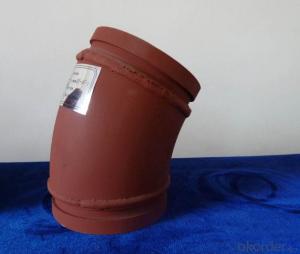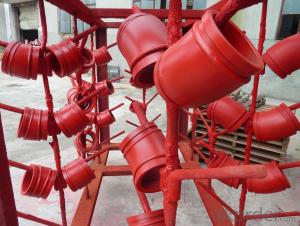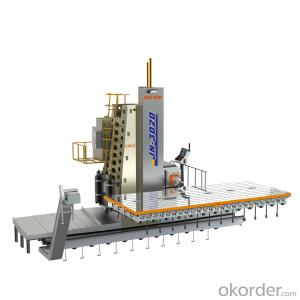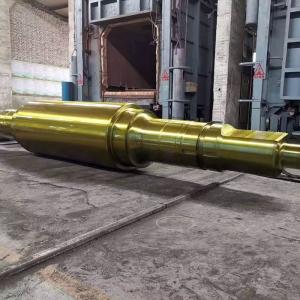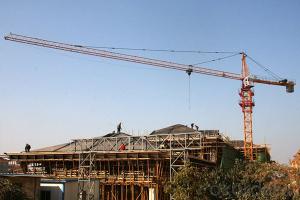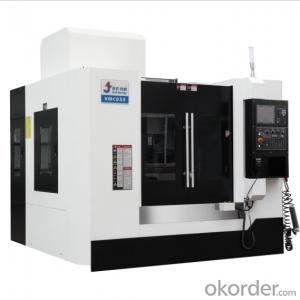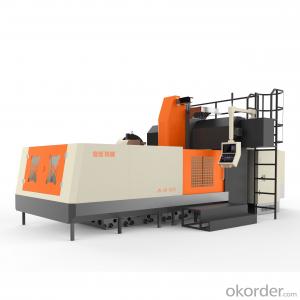Twin Wall Elbow for Concrete Pump R275 30DGR
- Loading Port:
- Tianjin
- Payment Terms:
- TT or LC
- Min Order Qty:
- 50 pc
- Supply Capability:
- 5000 pc/month
OKorder Service Pledge
OKorder Financial Service
You Might Also Like
Product Description:
Product Name: Twin Wall Pipe for Concrete Pump Pipe
Specification
(1) Material: Q235 (outside) + GCr15(inside)
(2) Thickness: 3mm (outside) + 9mm (inside)
(3) Technology: Quenching under high temperature
(4) Characteristics: the inner rigidity to 63 HRC; the outside has so high toughness to keep the inner.
(5) Matched with: Twin wall flange, Alloy (GCr15) + 20#
(6) Working Pressure:170bar
(7) Service life: above 60,000 cubic meters.
(8) Package: PP woven bag and plastic cap
Twin wall elbow is created with research of us and need of the market. Its service life and working pressure are better than the casting. Besides, We can supply 90D, 45D, 30D, 25D, 20D, 15D, 10D. And it can be used for PM, JUNJIN, Schwing, Cifa, Sany, ect.
3. Application
Concrete delivery.
4. Package
Put into containers.
FAQ:
Q1: Why buy Materials & Equipment from OKorder.com?
A1: All products have its ISO certifications, adheres to the highest standards and a commitment to supply chain safety and customer satisfaction.
Q2: How do we guarantee the quality of our products?
A2: We have established an advanced quality management system which conducts strict quality tests at every step, from raw materials to the final product. At the same time, we provide extensive follow-up service assurances as required.
Q3: How soon can we receive the product after purchase?
A3: Within three days of placing an order, we will begin production. The specific shipping date is dependent upon international and government factors, but is typically 10 to 30 workdays.
Q4: If we can produce Twin Wall Pipe for Concrete Pump Pipe according to customers request?
A4: Yes, we can produce Twin Wall Pipe for Concrete Pump Pipe according to the difference country situations to make it suitable to the market and customers. We have very professional technical team to make the design.
Q5: How to make a quick resolution for after service?
A5: We have overseas branches all-around of world, If needed, the seller shall dispatch 2 engineers to the buyer's site for supervision of training. The buyer shall make available of necessary facilities &skilled personnel at site for training.
Images:



- Q:How often should hopper agitator shafts be inspected or replaced in a concrete pump?
- Hopper agitator shafts in a concrete pump should be inspected regularly, ideally during routine maintenance checks, to ensure they are in proper working condition. The frequency of inspections may vary depending on the usage and operating conditions of the concrete pump. However, a general recommendation would be to inspect or replace hopper agitator shafts at least once every 6 to 12 months to prevent any potential issues or malfunctions.
- Q:How do I ensure the reliability of concrete pump spare parts in critical applications?
- To ensure the reliability of concrete pump spare parts in critical applications, there are several steps you can take: 1. Choose a reputable supplier: Research and select a trusted supplier known for providing high-quality concrete pump spare parts. Look for suppliers with a strong track record, positive customer reviews, and certifications that demonstrate their commitment to quality and reliability. 2. Verify product specifications and certifications: Before purchasing any spare parts, carefully review the product specifications and certifications. Ensure that the parts meet the required standards and have undergone rigorous testing to guarantee their reliability in critical applications. 3. Conduct regular maintenance and inspections: Implement a comprehensive maintenance and inspection schedule for your concrete pump and its spare parts. Regularly check for signs of wear, damage, or malfunction. Replace any parts that show signs of deterioration or that no longer meet the required specifications. 4. Use genuine spare parts: Always opt for genuine spare parts that are specifically designed for your concrete pump model. Genuine parts are manufactured to the highest standards and are more likely to provide reliable performance in critical applications compared to generic or counterfeit alternatives. 5. Keep an inventory of critical spare parts: Identify the most critical spare parts that are prone to failure or wear and keep an inventory of these parts on hand. This will minimize downtime in case of unexpected failures and ensure that you can quickly replace any faulty components. 6. Train and educate operators: Provide thorough training to your concrete pump operators on proper handling and maintenance of spare parts. Educate them on the importance of following manufacturer guidelines and best practices to maximize the reliability and longevity of the equipment. 7. Prioritize safety: Safety should always be a top priority in critical applications. Ensure that the spare parts you use are compliant with safety regulations and standards. Regularly assess and update safety protocols to minimize the risk of accidents or equipment failure. By following these steps, you can enhance the reliability of concrete pump spare parts in critical applications, reducing the likelihood of downtime and ensuring the smooth operation of your equipment.
- Q:How do I properly maintain and replace hydraulic filters in concrete pump spare parts?
- Proper maintenance and replacement of hydraulic filters in concrete pump spare parts is crucial to ensure the longevity and efficiency of your equipment. Here are some steps to follow: 1. Understand the manufacturer's recommendations: Start by familiarizing yourself with the manufacturer's guidelines for maintaining and replacing hydraulic filters. These instructions may vary depending on the specific pump model and filter type. 2. Regular inspection: Regularly inspect your hydraulic filters for any signs of damage, clogging, or excessive wear. Look for dirt, debris, or other contaminants that may hinder the filter's performance. If you notice any issues, it is important to address them promptly. 3. Follow a maintenance schedule: Implement a regular maintenance schedule for your hydraulic filters. This schedule should include regular filter inspections, cleaning, and replacement intervals. Adhering to a schedule will help prevent unexpected breakdowns and keep your concrete pump running smoothly. 4. Cleaning the filters: If your hydraulic filters are designed to be cleaned and reused, make sure to follow the proper cleaning procedure. This typically involves removing the filter, washing it with an appropriate cleaning solution, and allowing it to dry thoroughly before reinstallation. Be cautious not to damage the filter during the cleaning process. 5. Replacement: Over time, hydraulic filters will become less effective at filtering out contaminants. It is important to replace them according to the manufacturer's recommended intervals or sooner if they appear excessively dirty or damaged. Always use genuine spare parts to ensure compatibility and optimal performance. 6. Proper installation: When replacing hydraulic filters, ensure that they are installed correctly and securely. Pay attention to any seals or gaskets that may need to be replaced as well. Improper installation can lead to leaks or reduced filtration efficiency. 7. Monitor performance: After replacing the hydraulic filters, monitor the pump's performance closely. Pay attention to any changes in pressure, flow rate, or unusual noises. If you observe any abnormalities, it may indicate a problem with the filter or other components, and further investigation may be necessary. By following these steps, you can properly maintain and replace hydraulic filters in your concrete pump spare parts, ensuring optimal performance and prolonging the lifespan of your equipment.
- Q:Are there any specific quality control measures for the production of concrete pump spare parts?
- Yes, there are specific quality control measures for the production of concrete pump spare parts. These measures include rigorous inspection and testing processes at various stages of production to ensure that the spare parts meet the required specifications and standards. The quality control measures may involve dimensional checks, material testing, performance evaluation, and adherence to industry regulations. Additionally, manufacturers may implement quality management systems, such as ISO 9001, to maintain consistent quality and continuous improvement in the production of concrete pump spare parts.
- Q:What are the signs of a clogged or damaged hydraulic filter?
- A clogged or damaged hydraulic filter may be indicated by several signs. One of the most common signs is a decrease in hydraulic system performance. If you observe a decrease in the speed or power of your hydraulic equipment, it may be due to a clogged filter that restricts the flow of hydraulic fluid. Another sign is an increase in heat within the hydraulic system. As the system struggles to maintain proper fluid flow and pressure, a clogged or damaged filter can cause it to overheat. Furthermore, unusual noises may be noticed coming from the hydraulic system. A clogged filter can result in air becoming trapped in the system, leading to strange noises like whining or grinding. Moreover, the presence of dirty or discolored hydraulic fluid could suggest a clogged or damaged filter. The filter's purpose is to remove dirt and contaminants from the fluid, so if it fails to do so effectively, the fluid will become dirty and discolored. Finally, frequent or recurring issues with the hydraulic system could be an indication of a clogged or damaged filter. The filter plays a critical role in maintaining the overall health of the hydraulic system, so if it is not functioning properly, it can lead to other problems such as pump failure or valve blockages. Regular inspection and replacement of hydraulic filters are crucial to ensure the proper functioning and longevity of your hydraulic system.
- Q:What are the potential risks of using non-standard or modified hydraulic components in concrete pump spare parts?
- The potential risks of using non-standard or modified hydraulic components in concrete pump spare parts include compromised safety and performance. Non-standard or modified components may not meet the necessary specifications or standards required for safe and efficient operation. This can result in increased wear and tear, reduced reliability, and potential failures, leading to accidents, injuries, or damage to the equipment. Additionally, the use of non-standard components may void warranties and make it difficult to find replacement parts in the future. It is crucial to use approved and genuine hydraulic components to ensure the proper functioning and longevity of the concrete pump.
- Q:Can concrete pump spare parts be repaired or refurbished?
- Yes, concrete pump spare parts can be repaired or refurbished. Many common spare parts such as seals, bearings, valves, and hydraulic components can be repaired or refurbished to extend their lifespan and save costs. Repairing or refurbishing these parts can involve replacing worn-out or damaged components, reconditioning or re-machining certain parts, and performing necessary maintenance and testing to ensure their proper functionality. Additionally, some manufacturers or specialized companies may offer services for repairing or refurbishing specific concrete pump spare parts, allowing for a more cost-effective solution compared to purchasing brand new parts. However, it is important to note that not all spare parts can be repaired or refurbished, especially if they are severely damaged or have exceeded their recommended service life. In such cases, it may be more practical and safer to replace the parts with new ones.
- Q:How often should hydraulic filters be replaced in a concrete pump?
- Hydraulic filters in a concrete pump should be replaced on a regular basis to ensure optimal performance and longevity of the equipment. The exact frequency of replacement will depend on various factors such as the specific model of the concrete pump, the operating conditions, and the quality of hydraulic fluid used. As a general guideline, it is recommended to replace hydraulic filters in a concrete pump every 500 to 1,000 operating hours or at least once a year, whichever comes first. However, it is essential to refer to the manufacturer's recommendations and guidelines for the specific model of the concrete pump, as they may have specific maintenance schedules and intervals. Regular inspection of the hydraulic filters is also crucial to determine if replacement is necessary sooner than the recommended interval. If the filters are clogged, damaged, or show signs of excessive wear, they should be replaced immediately to prevent any potential damage to the hydraulic system. Additionally, if the concrete pump is operating in harsh or dusty environments, the filters may need to be replaced more frequently to ensure proper filtration and prevent contamination. Overall, proper and timely replacement of hydraulic filters in a concrete pump is essential to maintain the efficiency and reliability of the equipment, prevent potential breakdowns, and extend its service life.
- Q:How can a malfunctioning control lever affect the pump's operation?
- A malfunctioning control lever can significantly impact the pump's operation. It may cause the pump to operate at incorrect speeds, resulting in inefficient performance or potential damage to the pump. Additionally, a malfunctioning control lever can lead to improper fluid flow control, leading to inconsistent or inaccurate output. Overall, it is crucial to promptly address any issues with the control lever to ensure the pump operates reliably and efficiently.
- Q:How often should concrete pump control boxes be inspected and replaced?
- Concrete pump control boxes should be inspected regularly, ideally every 6 to 12 months, to ensure they are in good working condition. The replacement of control boxes should be done only when necessary, such as when they are damaged or malfunctioning, and should be based on the manufacturer's recommendations and industry standards.
1. Manufacturer Overview |
|
|---|---|
| Location | |
| Year Established | |
| Annual Output Value | |
| Main Markets | |
| Company Certifications | |
2. Manufacturer Certificates |
|
|---|---|
| a) Certification Name | |
| Range | |
| Reference | |
| Validity Period | |
3. Manufacturer Capability |
|
|---|---|
| a)Trade Capacity | |
| Nearest Port | |
| Export Percentage | |
| No.of Employees in Trade Department | |
| Language Spoken: | |
| b)Factory Information | |
| Factory Size: | |
| No. of Production Lines | |
| Contract Manufacturing | |
| Product Price Range | |
Send your message to us
Twin Wall Elbow for Concrete Pump R275 30DGR
- Loading Port:
- Tianjin
- Payment Terms:
- TT or LC
- Min Order Qty:
- 50 pc
- Supply Capability:
- 5000 pc/month
OKorder Service Pledge
OKorder Financial Service
Similar products
New products
Hot products
Related keywords

